The Scottish Government has published its blueprint for future transport investment, with a focus on active travel, public transport improvements and decarbonisation of the logistics sector.
The second Strategic Transport Projects Review (STPR2) makes 45 recommendations under six key themes, which could make transport in Scotland more sustainable and support people to make better, more informed choices on how they travel.
The recommendations include mass transit in Scotland’s biggest city regions of Glasgow, Edinburgh and Aberdeen. Clyde Metro represents a multi-billion investment that, when complete, could better connect over 1.5 million people in and around the Glasgow city region. Plans for Edinburgh & South East Scotland Mass Transit and Aberdeen Rapid Transit will also be developed.
The Scottish government will also invest further in ferry renewals, improving port infrastructure and connections from ferry terminals to other types of public transport. It hopes this will reduce car reliance, enhancing island connectivity and making safety improvements on rural trunk roads where accident rates and severities are typically higher.
Furthermore, as transport is Scotland’s biggest carbon emitter the recommendations emphasise decarbonisation and behaviour change for ferries, rail and buses as well as increasing the shift to zero-emission vehicles.
It will also look to encouraging more people to walk, wheel and cycle more often; cutting carbon emissions and improving health and wellbeing, particularly of children, while supporting sustainable economic growth.
Additionally, the Scottish government pledged to develop a net-zero freight and logistics network for Scotland that would encourage the switch from road to rail or water and reduce the overall distance travelled, including a review of rail freight terminals/ hubs.
Cabinet secretary for net zero, energy and transport, Michael Matheson, said: “The pandemic has led to fundamental shifts in travel behaviours and we want to ensure that people continue to make sustainable travel choices, that they return to public transport and our economic recovery does not overly rely on road-based travel.
“The STPR2 recommendations support the measures set out last week in our route map to reduce car kilometres by 20% by 2030 and represent a major piece of work by this government to make Scotland – all of Scotland – more sustainable.
“This review represents a repositioning of our transport investment priorities – the focus is firmly on how transport can help us protect our climate and improve lives. It takes a balanced and fair approach to all modes of transport, and all areas of Scotland.”
These plans will now go out for consultation, Matheson urged community groups, businesses and public and third sector organisations to share their views on STPR2.





